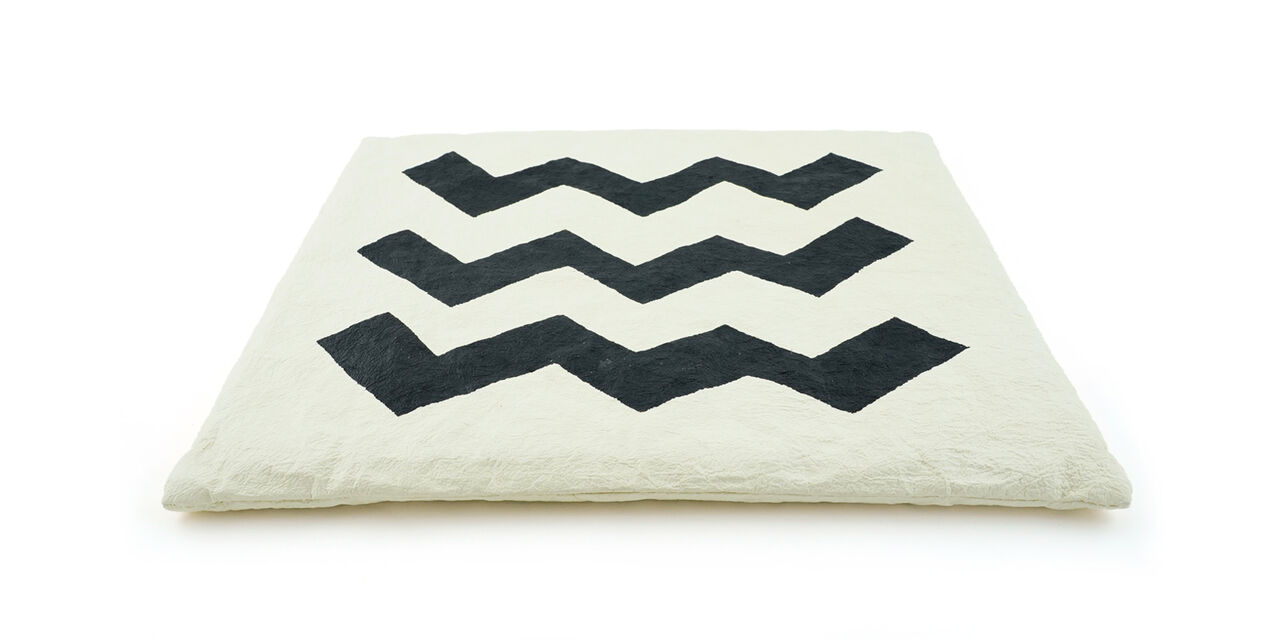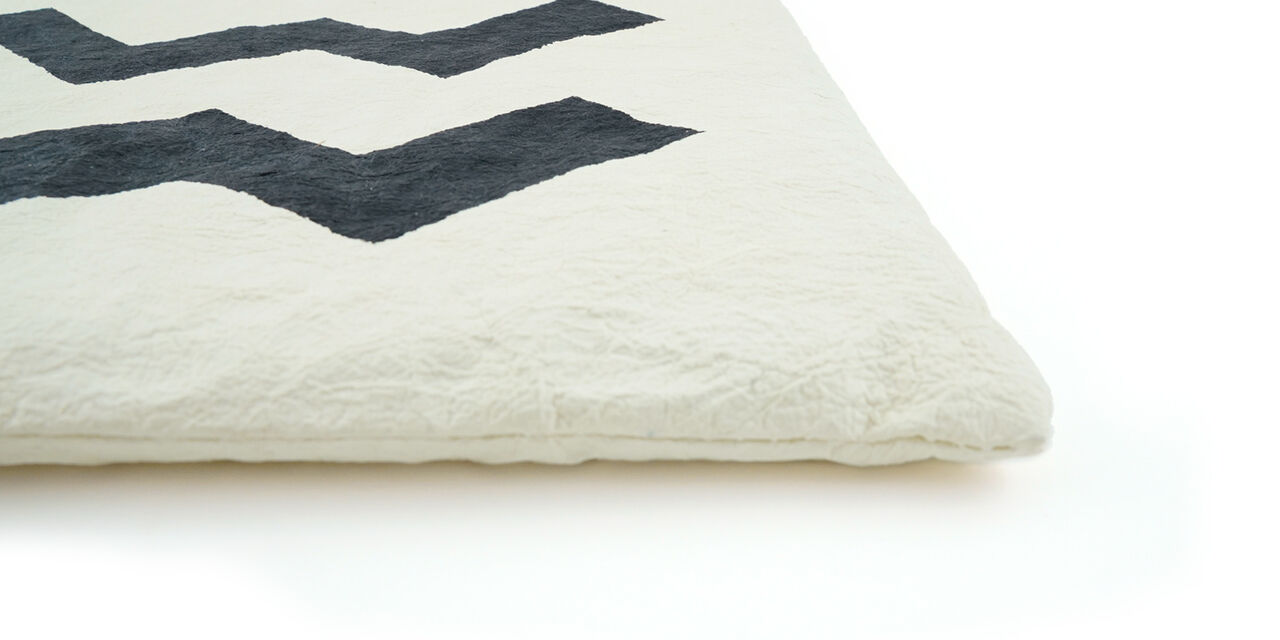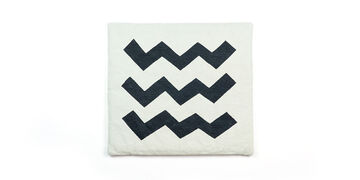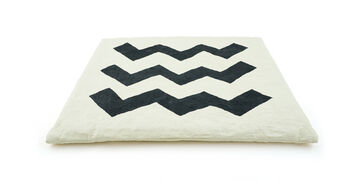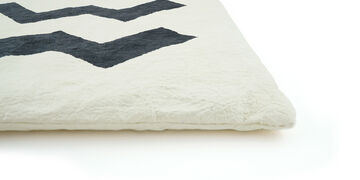Keijusha
Washi Square Chair Cushion White
Made in
Japan
New
Large Item
Low in Stock
Sold Out
This product is not available in your market
2014009900608
2014009900608
With the Passage of Time, “Yatsuo Washi” Paper Has a Good Aged Appearance of Glossy Surface and Softness.
Made of handmade Japanese washi papers with beautiful patterns that are stencil dyed by hand.
The traditional folkcraft pattern is easy to mix and match with both old and new things at home.
The colors of these chair cushions acquire deeper hues with years of use. With the passage of time, the washi paper has a good aged appearance of glossy surface and softness.
"Yatsuo Washi" paper is a traditional handicraft from Toyama Prefecture. It is strong, durable, capable of being shaped into a tote bag. This durable paper was traditionally used to make the bags of Toyama's traveling patent medicine peddlers.
Keisuke Yoshida is the founder of Keijusha. He was keen on saving what was already an industry in decline and to revive traditional papermaking so it would survive into the future. His paper products were highly praised by Mingei leader Muneyoshi Yanagi, prompting the development of a type of washi (used by famed Mingei textile designer Keisuke Serizawa) that wouldn't tear even when wet. Yoshida studied stencil dyeing and design directly from Keisuke Serizawa, enabling him to produce outstanding washi items. He designed the signboard, paper bags, shop curtains, wrapping papers, etc.
In fact, his sense of aesthetics lives on throughout Toyama, and he can rightly be credited with making Toyama a more beautiful prefecture.
Made of handmade Japanese washi papers with beautiful patterns that are stencil dyed by hand.
The traditional folkcraft pattern is easy to mix and match with both old and new things at home.
The colors of these chair cushions acquire deeper hues with years of use. With the passage of time, the washi paper has a good aged appearance of glossy surface and softness.
"Yatsuo Washi" paper is a traditional handicraft from Toyama Prefecture. It is strong, durable, capable of being shaped into a tote bag. This durable paper was traditionally used to make the bags of Toyama's traveling patent medicine peddlers.
Keisuke Yoshida is the founder of Keijusha. He was keen on saving what was already an industry in decline and to revive traditional papermaking so it would survive into the future. His paper products were highly praised by Mingei leader Muneyoshi Yanagi, prompting the development of a type of washi (used by famed Mingei textile designer Keisuke Serizawa) that wouldn't tear even when wet. Yoshida studied stencil dyeing and design directly from Keisuke Serizawa, enabling him to produce outstanding washi items. He designed the signboard, paper bags, shop curtains, wrapping papers, etc.
In fact, his sense of aesthetics lives on throughout Toyama, and he can rightly be credited with making Toyama a more beautiful prefecture.
Dimensions (approx.): width 350mm x 390mm x height 20mm
Material: Washi paper
Material: Washi paper
Keijusha
Yatsuo Town in Toyama Prefecture has long been a production area that uses melted snow water to make high-quality Japanese paper. At a time when the industry was already in decline due to substitutes such as machine-made paper and plastic, the founder, Keisuke Yoshida, established a papermaking company, which later became Keijusha. During the Mingei (folk art) movement, he was influenced by Muneyoshi Yanagi and Keisuke Serizawa and produced processed goods using stencil dyeing techniques on strong paper called “Kyoseishi” that was developed independently.
Yatsuo Town in Toyama Prefecture has long been a production area that uses melted snow water to make high-quality Japanese paper. At a time when the industry was already in decline due to substitutes such as machine-made paper and plastic, the founder, Keisuke Yoshida, established a papermaking company, which later became Keijusha. During the Mingei (folk art) movement, he was influenced by Muneyoshi Yanagi and Keisuke Serizawa and produced processed goods using stencil dyeing techniques on strong paper called “Kyoseishi” that was developed independently.
・Please do not wash with water.
・When cleaning dust and dirt on the surfaces, moisten the cloth with neutral detergent for lightly wiping.
・Because it is hand-dyed, the color may fade with use.
・Please do not leave it in direct sunlight for a long time.
・When cleaning dust and dirt on the surfaces, moisten the cloth with neutral detergent for lightly wiping.
・Because it is hand-dyed, the color may fade with use.
・Please do not leave it in direct sunlight for a long time.
With the Passage of Time, “Yatsuo Washi” Paper Has a Good Aged Appearance of Glossy Surface and Softness.
Made of handmade Japanese washi papers with beautiful patterns that are stencil dyed by hand.
The traditional folkcraft pattern is easy to mix and match with both old and new things at home.
The colors of these chair cushions acquire deeper hues with years of use. With the passage of time, the washi paper has a good aged appearance of glossy surface and softness.
"Yatsuo Washi" paper is a traditional handicraft from Toyama Prefecture. It is strong, durable, capable of being shaped into a tote bag. This durable paper was traditionally used to make the bags of Toyama's traveling patent medicine peddlers.
Keisuke Yoshida is the founder of Keijusha. He was keen on saving what was already an industry in decline and to revive traditional papermaking so it would survive into the future. His paper products were highly praised by Mingei leader Muneyoshi Yanagi, prompting the development of a type of washi (used by famed Mingei textile designer Keisuke Serizawa) that wouldn't tear even when wet. Yoshida studied stencil dyeing and design directly from Keisuke Serizawa, enabling him to produce outstanding washi items. He designed the signboard, paper bags, shop curtains, wrapping papers, etc.
In fact, his sense of aesthetics lives on throughout Toyama, and he can rightly be credited with making Toyama a more beautiful prefecture.
Made of handmade Japanese washi papers with beautiful patterns that are stencil dyed by hand.
The traditional folkcraft pattern is easy to mix and match with both old and new things at home.
The colors of these chair cushions acquire deeper hues with years of use. With the passage of time, the washi paper has a good aged appearance of glossy surface and softness.
"Yatsuo Washi" paper is a traditional handicraft from Toyama Prefecture. It is strong, durable, capable of being shaped into a tote bag. This durable paper was traditionally used to make the bags of Toyama's traveling patent medicine peddlers.
Keisuke Yoshida is the founder of Keijusha. He was keen on saving what was already an industry in decline and to revive traditional papermaking so it would survive into the future. His paper products were highly praised by Mingei leader Muneyoshi Yanagi, prompting the development of a type of washi (used by famed Mingei textile designer Keisuke Serizawa) that wouldn't tear even when wet. Yoshida studied stencil dyeing and design directly from Keisuke Serizawa, enabling him to produce outstanding washi items. He designed the signboard, paper bags, shop curtains, wrapping papers, etc.
In fact, his sense of aesthetics lives on throughout Toyama, and he can rightly be credited with making Toyama a more beautiful prefecture.
Dimensions (approx.): width 350mm x 390mm x height 20mm
Material: Washi paper
Material: Washi paper
Keijusha
Yatsuo Town in Toyama Prefecture has long been a production area that uses melted snow water to make high-quality Japanese paper. At a time when the industry was already in decline due to substitutes such as machine-made paper and plastic, the founder, Keisuke Yoshida, established a papermaking company, which later became Keijusha. During the Mingei (folk art) movement, he was influenced by Muneyoshi Yanagi and Keisuke Serizawa and produced processed goods using stencil dyeing techniques on strong paper called “Kyoseishi” that was developed independently.
Yatsuo Town in Toyama Prefecture has long been a production area that uses melted snow water to make high-quality Japanese paper. At a time when the industry was already in decline due to substitutes such as machine-made paper and plastic, the founder, Keisuke Yoshida, established a papermaking company, which later became Keijusha. During the Mingei (folk art) movement, he was influenced by Muneyoshi Yanagi and Keisuke Serizawa and produced processed goods using stencil dyeing techniques on strong paper called “Kyoseishi” that was developed independently.
・Please do not wash with water.
・When cleaning dust and dirt on the surfaces, moisten the cloth with neutral detergent for lightly wiping.
・Because it is hand-dyed, the color may fade with use.
・Please do not leave it in direct sunlight for a long time.
・When cleaning dust and dirt on the surfaces, moisten the cloth with neutral detergent for lightly wiping.
・Because it is hand-dyed, the color may fade with use.
・Please do not leave it in direct sunlight for a long time.

